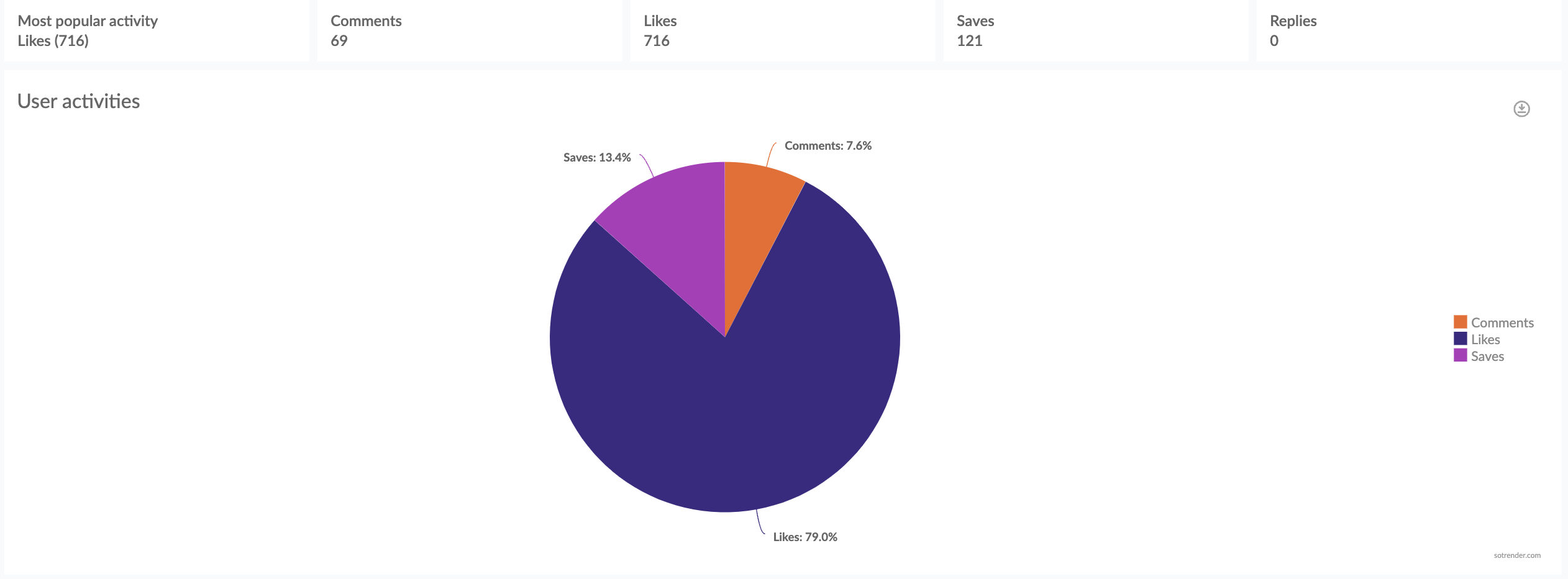How Instagram’s algorithm works is still a bit of a mystery for many Instagram users. But Instagram recently provided some answers to clear things up. And even if it seems trivial to some, being aware of the algorithm and understanding how it works is crucial. This is especially true if you want to achieve satisfying results from your marketing activities on this platform.
To help you understand it all, we’ve gathered the 12 biggest myths about the Instagram algorithm.
1. Switching to a business account will decrease your reach
Switching to a business account will not affect your reach on Instagram. So if you’re considering switching from a personal to a business account, don’t worry. Even if you switch many times between a personal and business account, it won’t impact your reach. That’s because Instagram sees your activities and is aware of what you’re doing (e.g. some users switch back to a personal account when they experience lower reach results with a business account).
It’s worth mentioning here that one of the main advantages of a business account is having access to Instagram Insights (data about your key metrics and performance). Keep in mind, however, that if you decide to switch back from a business profile to a personal one, you will lose all your data in Instagram Insights. Once you decide to switch back to a business profile once more, data will start to gather again.
Conclusion: Business and personal accounts are treated equally and have the same value. Your reach won’t decrease solely because you switched to a business profile.
2. Shadowbanning exists
Well, shadowbanning is not really a thing in the way people think it is. More precisely, it was not created on purpose by Instagram. According to Instagram representatives, they allow five categories of content on Instagram, though not all of those categories can be recommended in the Explore section. These categories include:
- content that might hinder their ability to create a safe environment (mentions of violence, certain mental health topics, regulated substances, sexually suggestive content),
- sensitive and low-quality content about health and finance (mentions of cures, cosmetic procedures, misleading business models),
- content that is regularly complained about (clickbait, promoting contests/giveaways, engagement bait),
- low-quality content (repurposed content from another account, content from sites that have too many clicks from Instagram compared to other platforms, news without clear details about the author),
- and misleading content (content that was proven to be false by fact-checkers or encourages the use of fake documents).
Some users find issues with the first category, as there have been complaints over the years by various groups that feel that their content should not violate their policies.
However, some activities may ban your account for some time, e.g. giving a massive amount of likes or following many accounts within a short time. But the aim of it is to get rid of spam and bots (or any other activities that look as such) and ban accounts that are using such practices.
Conclusion: Shadowbans don’t function in the ways that some users suspect them to. Some content might not be discoverable in the Explore page if it does not align with Instagram’s recommended content, and is this “punished” while other content is favoured. Additionally, some user activities may be banned.
3. Some functions are favoured by Instagram
Instagram does not magically favour some of its features. What we can only see is that it’s partially favouring its newest features, e.g. Reels which are now popping up in our feed more and more. However, using certain functions, like Reels, doesn’t mean the overall performance (e.g. engagement) of your Instagram efforts will automatically be improved.
Does it mean we can now resign from using all those fancy functions and post only photos? Not really. There are two key reasons for publishing different types of content:
- People have various preferences when it comes to consuming content. Some people prefer videos or Instagram Stories, while others only enjoy photos. To reach all your Instagram followers (and gain new ones as well!) and to give them what they like and what they expect, your published content on Instagram should have some variety.
- What you publish is also important from your perspective. Why? As you likely know already, creating an interesting and high-quality video is more time-consuming than posting (and even editing) a photo. You should always consider how much time you can spend on producing your Instagram content and adjust the time available to what is possible, keeping in mind the high quality of the final piece. Also, to some creators, some content formats will be more relevant than others. For example, if you’re a photographer, it’s obvious that you’ll post more photos than Reels.
Conclusion: If there is a new feature on Instagram, it’s a good idea to at least try it out for some time because it could be favoured. However, taking advantage of new Instagram functions won’t guarantee that the Instagram algorithm will treat your content better than others.
4. Instagram is hiding user posts
From time to time, influencers and creators complain that their posts are not visible on followers’ feeds. But according to Instagram representatives, hiding user posts doesn’t happen. By scrolling your feed, you will, sooner or later, see every post. The problem is that, currently, many users are following hundreds of profiles, so they’ll have to scroll their feeds for a long time every day to see all of those posts.
Also, remember that for Instagram, relationships with family and friends are considered more important than with other users, e.g. influencers or brands. So posts from family and friends are usually shown higher in the newsfeed.
Conclusion: Instagram is not hiding user posts in the newsfeed.
5. How the Instagram algorithm works is very simple
Well, not really. How the Instagram algorithm works and shows posts to users, is related to many factors, e.g.:
- When the post was published: posts published recently will be shown higher in the feed than posts added e.g. a few days ago.
- Our interests and preferences = the likelihood that a specific post will be interesting to us. The algorithm estimates, based on our previous interactions, what we might be interested in. For example, if we (in general) like or comment on content related to fashion more than to architecture, posts about fashion will be ranked higher in our feed. The same thing happens with different formats of content. So if we watch more videos than photos, we’ll see videos higher in our feed. The algorithm works the same in the Explore Feed – in this case, it will suggest more new content about fashion.
- Our relation with a specific profile: posts published by accounts with which we interact more (like, comment, tag each other, send DMs) will be ranked higher in the feed.
- Frequency of using the app: if you check Instagram a few times a day, you’ll see more recent posts each time. It’s different if we check it only a few times a week – in this case, each time you open the app, the algorithm will try to meet your needs by showing what it thinks are the most interesting posts, which may not be the most recent ones.
- The engagement under each post: once Instagram identifies that a specific post is interesting for many users (meaning has a quite decent engagement already), it will be suggesting it to other users, as they can find it interesting, too.
- How much time you spend on Instagram each time you use the app or how many accounts you follow.
It’s worth noting that the Instagram algorithm also knows whether a published photo was taken directly via the Instagram app or was added from the camera roll. It can also identify when the photo was taken, whether it’s published in real-time (just after taking it) or after some amount of time (like with the popular #throwback). Of course, the algorithm prefers pictures published in real-time. But, currently speaking, the majority of users focus on updating their Stories in real time and pay more time and attention to editing photos before publishing them on their profile. So don’t pay too much attention to this requirement.
Conclusion: Many factors have an effect on the order in which Instagram shows posts in user feeds.
6. The algorithm doesn’t know if our posts are interesting to Instagram users
This myth couldn’t be more wrong. Instagram perfectly knows what’s interesting and what’s not. How? It sees and analyses how long users are spending on content and whether they interact with it or not. The more users engage with your Instagram profile and content, the better it is for your overall Instagram performance. And it’s not only about active engagement in your posts (liking, commenting) but also e.g. spending time on your profile, scrolling through your posts, sending your posts via direct messages to other users, saving our posts, etc.
Another interesting fact is how the list of users who has seen your Stories is created. This is an issue that strikes many users. Contrary to what people believe, the list is not only based on how often we interact with each profile. According to Instagram, what matters most here is the amount of time other users spend on our profile and on consuming our content. It doesn’t have to be users, however, who interact with us and our content a lot (liking our posts, commenting etc). Those could be users who watch what we do without wanting us to know that they are interested in it.
Conclusion: Instagram, by analyzing how much time users spend on the content we publish, determines if it is going to be attractive to other users or not.
7. Chronological order in the feed will come back
Now, in 2024, the chronological order in users’ feeds is partially back. Depending on which Instagram feed you’d be looking at, you may see posts in chronological order.
- The main feed – is still the feed that is mainly built based on the algorithm recommendations.
- Following or Favourites feed – are two feeds that are now showing posts in chronological order.
What is the difference between the following and favourites feed?
- Following is the feed where you see posts from all the profiles that you follow.
- In the Favourites feed you will see only posts from accounts that you’ve added to your favourites list.
Conclusion: The chronological order is partially back (since 2022).
8. Top posts are the same for every Instagram user
This is another myth. Everything, even the best posts in the Explore Feed, is based on and adjusted to, our preferences and interests. TOP9 posts are then not objective, because they relate to each user’s behaviour on Instagram. It’s because of the fact that Instagram algorithm uses machine learning and artificial intelligence when delivering your feed.
The same relates to the Explore Page, where posts are presented according to our interests, preferences and previous searches. That means that each of us will have a completely different set of posts in the Explore Page. For example, if you are consuming a lot of content about sport and travelling, you will see a lot of similar content in the Explore Page.
Conclusion: Best posts are based on each user’s preferences and interests.
9. Deleting content doesn’t affect the work of the Instagram algorithm
We don’t recommend deleting any content published on your profile. Why? Instagram doesn’t like when something suddenly disappears, simply because it learns our behaviours. This is also why it’s so important to be regular in running your Instagram account. The algorithm is simply waiting for your next activity. It predicts that you’ll be active, and this regularity guarantees its stability. If the algorithm notices some unusual activity, too much activity in a short time, deleting content etc., you can expect worse results, such as a decline in reach and other metrics.
What if, for any reason, we no longer want to have a post on our profile but we already know that deleting them isn’t the best option? There is a special function for that and it’s called archive. You’ll find this option under each post, next to the ‘delete’ option. Archiving is not only better for the algorithm but also enables us to come back to these posts and even re-archive them to your profile.
Conclusion: We strongly recommend not deleting any type of content on Instagram as it may have a negative effect on the work of the Instagram algorithm. Always remember about the ‘archive’ option.
10. Buying likes and followers is a great way to improve the overall Instagram performance
It’s definitely not true and it’s one of the biggest mistakes you can make. Although it seems to be obvious, for many users it still isn’t. If you are happily and enthusiastically buying likes or followers, you should stop. Instagram knows what you’re doing and it knows that you’re cheating – it detects such behaviours and lately has been particularly less than tolerant towards them. Why? The latest direction of the Instagram policy aims at minimizing and getting rid of such activities (as well as using bots). So now you have to be very careful about that, more than you’ve ever been.
Buying likes and followers has one more drawback. They have almost no value, and any they have is only temporary and visible exclusively in numbers. In particular, bought followers don’t present any value when it comes to engagement (which we know is the most important metric recently) because most often those are only fake accounts. As such practices won’t have any positive effect on your Instagram presence, we wholeheartedly recommend avoiding them.
Conclusion: One of the biggest mistakes you can make is to buy likes or followers on Instagram.
11. Likes are the most valuable currency on Instagram that we should all fight for
A few years ago likes might have been quite a good way (and actually one of the few used) of measuring success on Instagram. In 2024, we should be leaning towards completely different metrics, though.
The number of likes is a metric that is increasingly easy to manipulate (e.g. by buying likes), but we should remember also that it is now possible to hide the number of likes under each and every post we publish.
Likes are also not the best indicator of the engagement we have on our profiles. The more effective way of measuring it could be by monitoring the following numbers:
- Link clicks in our bio (in the profile)
- Comments under posts
- Replies to Instagram Stories
- Clicks on the Swipe up link in Stories
- Content views and profile views
- Saved posts
- Conversions

Analyzing user activities in Sotrender
All these metrics can be analyzed in Sotrender. If you’d like to know how to measure engagement on Instagram step-by-step, we’ve already covered that as well.
Conclusion: To measure the effectiveness of an Instagram profile, and marketing success, analyzing only the number of likes is not enough. Many different metrics should, and could, be a measure of success on the platform.
12. Instagram Stories disappear after 24 hours, so there is no point to invest time to create them
There couldn’t be any more wrong statements. Stories are now even more likely to be viewed by users than the feed itself.
From the perspective of a brand, influencer or creator, it’s worth investing in Stories for several reasons:
- They’re more likely to have a higher conversion, as it’s much easier for users to take the expected action.
- It’s easier to engage users, as there are many various stickers available, like polls, quizzes, or ask a question sticker. By replying to Stories, it’s also much easier to send a DM (direct message), which helps to get us closer to other Instagram users.
- Stories are a much more effective way to build a relationship with followers in general; they are not only more direct but also give the feeling of being up to date.
- Even though Stories expire after 24 hours (they are no longer available to Instagram users after this time), it doesn’t mean they cannot be of value to users for longer. That’s why Highlights were created – it’s a place where we can save all the past Stories so that they are pinned to our profile for as long as we wish. It’s a great way to show who we are in more detail, what we do, what is our offer, or share anything that will be valuable or helpful to Instagram users.
We’ve also already discussed how Stories can help your business and how to use them in practice.
Conclusion: Instagram Stories are equally important as posts published on our profile. Year after year, their importance is even growing.
Reality vs living in harmony with the Instagram algorithm
We already know how the Instagram algorithm works, but how can we use this knowledge in practice and our everyday work? The best thing we can recommend is testing various solutions and verifying, on your own, every theory you come across. It’s not like they may not be true, but not every suggestion will have a positive impact on your performance. It all depends on your goals and the target audience you communicate with.
A good source of always up-to-date knowledge about Instagram and its algorithm is Instagram’s CEO, Adam Mosseri, Instagram profile. He regularly shares there all the necessary info about Instagram and the latest features.








